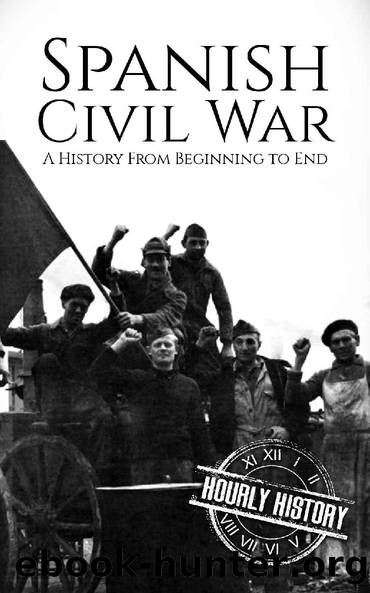Spanish Civil War: A History From Beginning to End by Hourly History

Author:Hourly History [History, Hourly]
Language: eng
Format: epub
Publisher: Hourly History
Published: 2018-05-01T00:00:00+00:00
Chapter Six
The Terror
âWe must extend the terror. We must impose the impression of dominion while eliminating without scruples everyone who does not think as we do.â
âGeneral Emilio Mola
All civil wars are brutal, but the Spanish Civil War was especially notable for the widespread killing of non-combatants, the execution of prisoners, and the deliberate employment of tactics designed to subdue opposition by the imposition of terror.
Massacres were almost routine during the civil war even from the very earliest days. When Nationalist troops occupied Malaga in early February 1937 for example, it has been estimated that around 4,000 suspected Republican sympathizers were summarily shot. Italian troops, who had been involved in the assault on the city, were reported to have been horrified by the scale and brutality of the killings of men and women. Some peopleâmainly pregnant women, women with young children, the elderly, and the sickâwere spared execution but were instead driven out of the city to the east, on the N340 road towards Republican Almeria, 200 kilometers away. The thinking was, apparently, that this would force the Republicans to feed these refugees whereas if they had been allowed to remain in Malaga, it would have become the responsibility of the Nationalists.
It is estimated that up to 50,000 refugees fled Malaga on foot and began the long trek to Almeria. They were subjected to almost continual strafing by Nationalist aircraft, attacks by following Italian tanks, and shelling by German warships. There was no military justification for this; none of the people fleeing the city were combatants, and the harassment seems to have been done for no other reason than to terrorize the civilians. No one is certain how many people died en-route to Almeria. Estimates vary from three to five thousand. What is certain is that, even up to the 1980s, human remains were still being discovered next to the N340 which is now a major tourist route from Malaga to Almeria.
This deliberate brutality towards civilians and prisoners characterized much of the fighting during the civil war. When Nationalist forces first began their attacks on Madrid in late 1936, many prisoners held by the Republicans were shot. These included civilians, Catholic priests, and soldiers who were believed to be sympathetic towards the Nationalist cause. The numbers killed are uncertain, but estimates range from three to twelve thousand.
Other massacres involved killing by both sides. In and around the town of Badajoz, for example, many people suspected of being Nationalists were killed by Republicans almost as soon as the war began. At one point, in the town of Fuente de Cantos, 56 people were forced into a church by Republican soldiers. The church was then set on fire. When Nationalist troops took the province of Badajoz, up to 12,000 civilians were executed in reprisal. This pattern of massacre followed by reprisal massacre was repeated throughout the war.
In some cases, the killing of civilians was done as a kind of military experiment. The bombing of the town of Guernica was one of the most famous examples.
Download
This site does not store any files on its server. We only index and link to content provided by other sites. Please contact the content providers to delete copyright contents if any and email us, we'll remove relevant links or contents immediately.
Blood and Oil by Bradley Hope(1529)
Wandering in Strange Lands by Morgan Jerkins(1372)
Ambition and Desire: The Dangerous Life of Josephine Bonaparte by Kate Williams(1344)
Daniel Holmes: A Memoir From Malta's Prison: From a cage, on a rock, in a puddle... by Daniel Holmes(1293)
It Was All a Lie by Stuart Stevens;(1265)
Twelve Caesars by Mary Beard(1256)
The First Conspiracy by Brad Meltzer & Josh Mensch(1140)
What Really Happened: The Death of Hitler by Robert J. Hutchinson(1128)
London in the Twentieth Century by Jerry White(1112)
Time of the Magicians by Wolfram Eilenberger(1089)
The Japanese by Christopher Harding(1086)
Twilight of the Gods by Ian W. Toll(1084)
Cleopatra by Alberto Angela(1062)
A Woman by Sibilla Aleramo(1054)
Lenin: A Biography by Robert Service(1045)
The Devil You Know by Charles M. Blow(985)
Reading for Life by Philip Davis(971)
The Life of William Faulkner by Carl Rollyson(925)
1965--The Most Revolutionary Year in Music by Andrew Grant Jackson(921)
